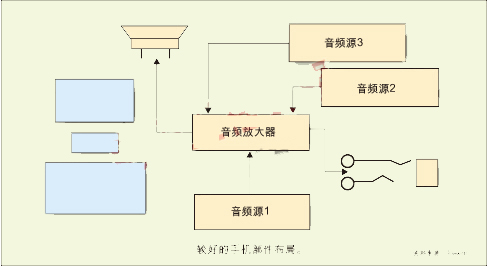This article refers to the address: http://
For PCB layout engineers, the mobile phone presents the ultimate challenge. Modern handsets contain almost all of the subsystems found in portable devices, and each subsystem has conflicting requirements. A well-designed board must maximize the performance of the various devices connected to it and avoid interference between multiple systems. The inconsistent requirements of each subsystem will inevitably lead to a decline in performance.Despite the increasing audio functionality in mobile phones, audio circuits are often the least noticed during board design. Here are some suggestions to help ensure a board that is well laid out without sacrificing audio quality.
should
- Carefully consider the underlying planning. The ideal underlying plan should divide the different types of circuits into different areas. Figure 1 shows a good underlying plan.
- Use differential signals whenever possible. Audio devices with differential inputs are able to reject noise. In the middle of the differential signal, the ground line cannot be added. Because the most important point of application of differential signals is the benefits of mutual coupling between differential signals, such as magnetic flux cancellation and noise immunity. If the ground wire is added in the middle, the coupling effect will be destroyed. There are two points to note for the wiring of the differential pair. One is that the length of the two lines should be as long as possible, and the other is that the spacing between the two lines (which is determined by the differential impedance) should remain the same, that is, to be parallel. There are two parallel ways, one is that the two lines are on the same side-by-side, and the other is that the two lines are on the top-by-side. In general, the side-by-side implementation of the former is more.
- Isolate the ground current to avoid digital currents increasing the noise of the analog circuitry. Basically, it is correct to isolate the analog/digital partitions. It should be noted that the signal trace should not cross the divided area as much as possible, and the return current path of the power supply and signal should not be changed too much. The requirement that the digital-to-analog signal traces cannot be crossed is because the digital signal with a slightly faster speed will return to the source of the digital signal as much as possible along the ground near the lower trace. If the digital-to-analog signal crosses, the return current The noise generated will appear in the analog circuit area.
- The analog circuit uses a star ground. Audio power amplifiers typically consume a large amount of current, which can have an adverse effect on their own ground or other reference ground.
• Turn unused areas on the board into ground planes. Ground coverage is achieved near the signal traces to shunt excess high frequency energy from the signal line to ground through capacitive coupling.

Figure 1: Better phone component layout
Should not
- Use a hybrid circuit on the board. Although the RF area of ​​a cell phone is generally considered analog, the noise coupled from the RF zone to the audio circuitry is demodulated into audible noise.
- The analog audio signal wiring is too long. Too long analog audio traces can be subject to noise from digital and RF circuits.
- Forget the importance of the ground loop. Systems with poor grounding can experience severe distortion, noise, crosstalk, and low RF immunity.
- A natural loop that interrupts the digital current. This path produces the smallest loop area that reduces antenna effects and inductance effects.
- Ignore the need to place the bypass capacitor in a position that is close to the power pin it is about to bypass.
Hot Melt Type Fiber Optic Fast Connector
Hot Melt Type Fiber Optic Fast Connector,Afl Fast Connect Lc,Fast Connector Fiber
Ningbo Fengwei Communication Technology Co., Ltd , https://www.fengweifiberoptic.com